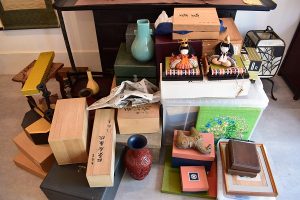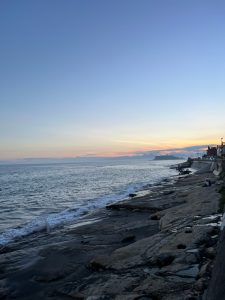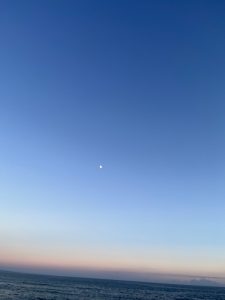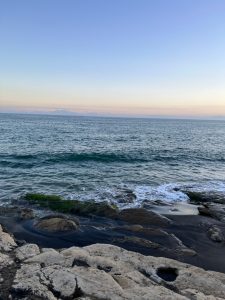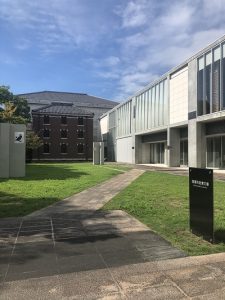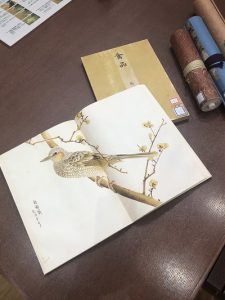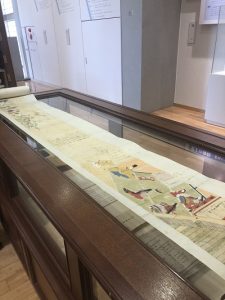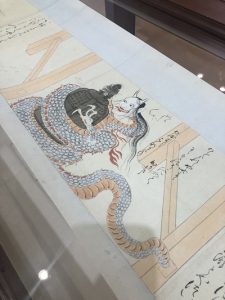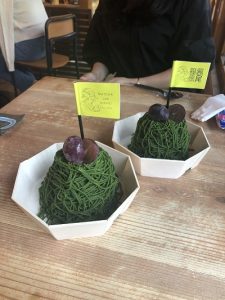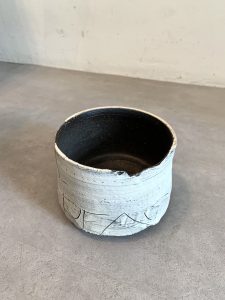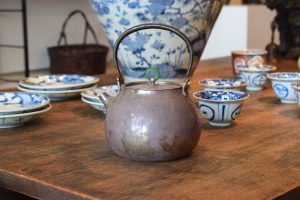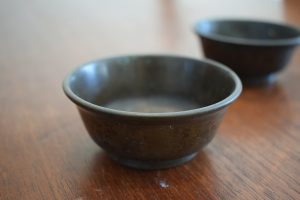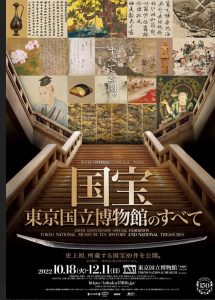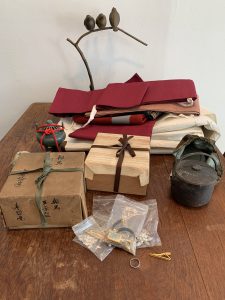皆さま、こんにちは。スタッフNでございます。
今日は9月6日キョロちゃんの日(森永チョコボールの日)だそうです。
キョロちゃんと言えば、昔アニメの絵描き歌が大好きでよく歌っておりました。
あのまん丸おめめと鼻にかかる声が、なぜかいまだに忘れられません。
OPは皆様ご存知CMの「クエ、クエ、クエ~♪」でございますね。
今朝もテレビ番組で、チョコボールの金と銀が出るか、芸人が生放送でひたすら箱を開けておりました。
さて、金と言えば先日留学生ご一考が、京都の金閣寺に行ってきた写真が届きました。

留学生の近況ですが、日本の家に来てからもう5回以上ドアに頭をぶつけているようで申し訳ないです。
すごい味のリコリスのお菓子をいただいたり、回転寿司に行ったり、花火をしたり、日本文化を教える代わりに、ちゃっかり青春に紛れ込んで楽しんでいるNでございます。
ここで金閣寺について調べてみました。
正式名称を鹿苑寺といい、相国寺の塔頭寺院の一つでございます。
舎利殿「金閣」が特に有名なため一般的に金閣寺と呼ばれています。
元は鎌倉時代の公卿、西園寺公経の別荘を室町幕府三代将軍の足利義満が譲り受け、山荘北山殿を造ったのが始まりとされています。
金閣を中心とした庭園・建築は極楽浄土をこの世にあらわしたと言われ、有名な一休禅師の父である後小松天皇を招いたり、中国との貿易を盛んにして文化の発展に貢献した舞台で、この時代の文化を特に北山文化といいます。
義満の死後、遺言によりお寺となり、夢窓国師を開山とし、義満の法号鹿苑院殿から二字をとって鹿苑寺と名づけられました。
義満は延文三年(1358)足利二代将軍義詮(ヨシアキラ)を父に、石清水八幡宮検校通清の娘良子を母として生まれ、幼名を春王と呼ばれました。
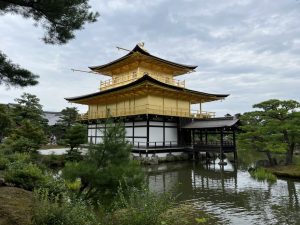
南北両朝の抗争が相次ぐ康安元年、義満三歳の時、楠正儀、細川清氏らに大挙して京都を攻められ、将軍義詮は近江へ逃れました。
義満は従者に抱かれ建仁寺の蘭洲良芳のもとに逃れましたが、良芳和尚は義満に僧衣をかぶせて五日間かくまい、ひそかに播州白旗城の赤松則祐のもとに送り届けました。そして翌年義満は無事京都に帰還しています。
貞治六年(1367)義満は天龍寺において時の住持春屋妙葩より受衣しています。
そしてこの春屋妙葩とその弟弟子義堂周信は義満にとって終生の変わらぬ精神的支えとなったのです。
この年父義詮は病没し、翌年義満は十一歳で将軍職を継ぎますが、父の遺言により、管領細川頼之が補佐役として幼君を助け、義満を立派な将軍に育て上げるとともに、幕府の権威の向上に努めました。
十一才で将軍職を継いだ義満は細川頼之の補佐を受けながら、地方の有力な守護大名を制御して将軍としての地位を確立していきました。
そして応安四年(1371)室町北小路に造営中の室町第を完成させ、ここに幕府を移します。
そこは大きな池を掘って鴨川の水を引き、庭には四季の花を植え、それらの花が爛漫と咲き乱れたといいます。その様を見て人々は「花の御所」と呼びました。
この時まだ南北両朝の分裂は続いており、細川頼之らの努力でようやく統一の兆しが見え始めていた頃でもありました。
北山という地名は平安時代に遡るといわれますが、平安時代の北山には霊厳寺、興隆寺、法音寺等の寺院が建てられていました。
また天皇の陵墓をはじめ多くの塚があり、火葬が行われたころでもありました。
この土地はやがて鎌倉時代に権勢を誇った西園寺家のものとなり、公経によって「北山第」という豪壮な山荘が営まれました。
しかし鎌倉幕府が倒されると共に西園寺家もその権勢の座から遠ざかり、西園寺家の衰退と共に北山第も荒廃していったのです。
この北山第を足利義満が譲り受け北山殿を造営したのです。
義満は室町に室町第を造営し幕府を移しました。
そこは花の御所と呼ばれ、政治の中心地となります。
そして夢窓国師の弟子であった春屋妙葩禅師について参禅弁道にはげみ一寺の建立を思い立ち、幕府の隣に相国寺を建てたのです。
この相国寺を中心に五山文学が生まれ文化の中心地としても栄えました。
しかし義満はこれにも満足せず、当時荒廃していた北山第の大改修をはじめ、北山殿を造営したのです。
その中の舎利殿が金閣で、一層に釈迦三尊が安置され、二層目は観音殿、三層に仏舎利がおさめられました。
その後それまで室町殿で行われていた行事などは北山殿で行なわれるようになり、その機能が移されました。
対明貿易をはじめた義満は明の勅使を北山殿で迎えています。
こうして得た中国のさまざまな文化が集められ、北山文化を築いたのです。
義満の死後北山殿は将軍の邸としての資格を失いますが、義満の遺言により禅寺となり、義満の法号である鹿苑院殿より鹿苑寺となります。
初期の鹿苑寺についてはあまり正確にはわかっていません。
足利三代将軍義満は、応永元年(1394年)将軍職を僅か九歳の義持に譲り、翌年自らも三十八歳の若さで出家しました。
これは義満自身九歳の年に父義詮の死に遭い、数々の苦難を経験しましたが南北両朝の合一にも成功し、世の中に太平が回復すると同時に、公的生活から離れてもっと自由な行動を望んだものと思われます。
荒廃していた西園寺家の西園寺・北山第を譲り受けた義満は、応永四年(1397年)ここに山荘北山殿を造営すべく工事を開始しました。
庭園、建築共に可能な限りの粋をつくしましたが、中でもとくに趣向をこらしたのが、舎利殿つまり金閣でした。
応永十五年(1408年)後小松(ごこまつ)天皇の行幸を仰いで、義満は盛大な宴を開きましたが、これは北山行幸と呼ばれ、今に語りつがれています。義満は五十一歳でこの世を去るまでここに住んでいました。
義満の死後義持は夢窓国師を勧請して開祖とし、初めて鹿苑寺と名づけられました。
将軍家の庇護のもとにあった多くの禅院は、将軍家の権威の衰退と共に経済的にも困難に陥っていきます。
そして応仁の乱の勃発によって、本山相国寺をはじめ多くの禅寺が焼討にあい、鹿苑寺もその被害にあいましたが、金閣、石不動堂、護摩堂などは焼失を免れました。
その後足利十五代の歴史は終わりをつげ、安土桃山の激変期を経て、徳川家康によって平安の時代となります。
徳川家康の命により鹿苑寺住職となったのが西笑承兌でした。
西笑和尚は豊臣秀吉、徳川家康の二人に政治顧問として重用され「黒衣の宰相」といわれた人です。
西笑承兌によって鹿苑寺はその経済的基盤を固め、以後、西笑の法系によって受け継がれてきました。
日本を代表する金閣寺、さらに知識を深めることができました。
金の骨董もお待ちしております。
ではでは
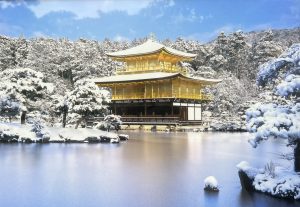
Hello everyone. I am Staff N.
Today, September 6th, is Kyoro-chan’s Day (Morinaga Chocoball Day).
Speaking of Kyoro-chan, I used to love anime drawing songs and often sang them.
For some reason, I still can’t forget those round eyes and the voice that hits my nose.
The OP is the CM “Kue, Kue, Kue~♪” that everyone knows.
This morning, on a TV program, a comedian was intently opening the box on a live broadcast to see if the gold and silver chocolate balls would come out.
By the way, speaking of money, the other day I received a photo of an international student visiting Kinkakuji in Kyoto.
Regarding the recent situation of international students, I am sorry that I seem to have hit my head against the door more than five times since I came to my home in Japan.
Instead of eating amazing licorice sweets, going to conveyor belt sushi restaurants, setting off fireworks, and teaching Japanese culture, I’m N who shrewdly slips into youth and enjoys himself.
I researched Kinkakuji here.
Its official name is Rokuonji, and it is one of the sub-temples of Shokokuji.
It is generally called Kinkaku-ji because the reliquary hall “Kinkaku” is particularly famous.
It is said that the villa of the Kamakura period court noble Kintsune Saionji was inherited by Yoshimitsu Ashikaga, the third shogun of the Muromachi Shogunate, and the mountain villa Kitayamadono was built.
The garden and architecture centered on the Kinkaku are said to represent the Pure Land of Bliss to the world, and it is a stage that has contributed to the development of culture by inviting Emperor Gokomatsu, the father of the famous Zen master Ikkyu, and by thriving trade with China. The culture of this period is called the Kitayama culture.
After Yoshimitsu’s death, it became a temple in accordance with his will, with Muso Kokushi as the founder of the temple.
Yoshimitsu was born in the 3rd year of Enbun (1358) to Yoshiakira, the second shogun of Ashikaga, and Yoshiko, the daughter of Kengyo Michikiyo of Iwashimizu Hachimangu Shrine, and his childhood name was Haruo.
In the first year of the Koan era, when Yoshimitsu was three years old, when the conflicts between the Northern and Southern Courts continued, Kyoto was attacked en masse by Masayoshi Kusunoki, Kiyouji Hosokawa, and others, and Shogun Yoshiakira fled to Omi.
Yoshimitsu escaped to Ranshu Ryoho at Kennin-ji Temple with his followers, but Ryoho hid Yoshimitsu in a monk’s robe for five days, and secretly lived with Akamatsu Norisuke at Banshu Shirahata Castle. sent to. The following year, Yoshimitsu returned to Kyoto safely.
In the 6th year of the Sadaji era (1367), Yoshimitsu was appointed as the chief priest of Tenryu-ji Temple by Myohan, the chief priest of the time.
Haruya Myohan and his younger disciple Gido Shunobu became Yoshimitsu’s constant spiritual support throughout his life.
In this year, his father Yoshiakira died of illness, and the following year Yoshimitsu succeeded to the position of shogun at the age of eleven. I tried to improve the authority of
Yoshimitsu, who succeeded to the post of shogun at the age of eleven, established his position as shogun by controlling the influential shugo daimyo of the region while receiving the assistance of Yoriyuki Hosokawa.
In the 4th year of Oan (1371), the Muromachi Dai, which was under construction in Muromachi Kitakoji, was completed, and the shogunate moved here.
It is said that a large pond was dug there to draw water from the Kamogawa River, and flowers of the four seasons were planted in the garden, and these flowers bloomed profusely. When people saw it, they called it “Hana no Gosho”.
At this time, the division between the Northern and Southern Dynasties was still continuing, and signs of unification were finally beginning to appear thanks to the efforts of Yoriyuki HOSOKAWA and others.
The name Kitayama is said to date back to the Heian period, when temples such as Reigon-ji, Koryu-ji, and Hoon-ji were built in Kitayama.
In addition, there are many mounds, including the tombs of emperors, and it was also the time when cremation was performed.
This land eventually came under the control of the Saionji family, who held great power during the Kamakura period, and Kintsune ran a magnificent mountain villa called Kitayamadai.
However, when the Kamakura shogunate was overthrown, the Saionji family also lost its position of power.
Yoshimitsu Ashikaga took over Kitayamadai and built Kitayamaden.
Yoshimitsu built Muromachi Dai in Muromachi and transferred the shogunate.
It was called Hana no Gosho and became the center of politics.
And he came up with the idea of building Gemi Ichiji Temple in Zen Zen Bendo with Haruya Myohan, a disciple of Muso Kokushi, and built Shokokuji next to the Shogunate.
Gozan literature was born around Shokoku-ji Temple, and it flourished as a center of culture.
However, Yoshimitsu was not satisfied with this, and began the major renovation of Kitayama Dai, which was in ruins at the time, and built the Kitayama Palace.
Among them, the reliquary hall is the Golden Pavilion, the Shakyamuni Triad is enshrined on the first floor, the Kannonden on the second floor, and the reliquary of Buddha on the third floor.
After that, events that had been held at the Muromachi-dono Hall were now held at the Kitayama-dono Hall, and its functions were transferred.
Yoshimitsu, who started trading with Ming, welcomed Ming’s imperial envoy at Kitayama-dono.
Various Chinese cultures acquired in this way were collected and built the Kitayama culture.
After Yoshimitsu’s death, Kitayama-dono lost its status as a shogun’s residence, but in accordance with Yoshimitsu’s will, it became a Zen temple, and from Yoshimitsu’s Buddhist name, Rokuon-in-den, it became Rokuon-ji.
Not much is known about the early Rokuonji.
In 1394, Yoshimitsu, the third shogun of Ashikaga, handed over the position of shogun to Yoshimochi, who was only nine years old.
When Yoshimitsu was nine years old, his father Yoshiakira died, and he experienced many hardships. It seems that he wanted to take action.
In 1397, Yoshimitsu took over Saionji and Kitayamadai from the Saionji family, which had fallen into disrepair.
He tried to be as sophisticated as possible in both the garden and the architecture, but the reliquary hall, or Kinkaku (Golden Pavilion), was of particular interest.
In the 15th year of Oei (1408), Yoshimitsu held a grand banquet in anticipation of Emperor Gokomatsu’s visit. Yoshimitsu lived here until he passed away at the age of fifty-one.
After Yoshimitsu’s death, Yoshimochi recruited Muso Kokushi to become the founder and named Rokuonji for the first time.
Many Zen temples under the patronage of the shogun family fell into financial difficulties as the authority of the shogun family declined.
When the Onin War broke out, many Zen temples, including Shokoku-ji Temple, were burned down, and Rokuon-ji Temple was also damaged, but Kinkakuji Temple, Ishifudo-do Hall, and Goma-do Hall escaped destruction.
After that, the history of the 15th generation of Ashikaga came to an end, and after a period of upheaval in Azuchi-Momoyama, Tokugawa Ieyasu entered the Heian period.
Jota Saisho became the chief priest of Rokuon-ji Temple by order of Ieyasu Tokugawa.
Saisho Osho was appointed as a political adviser to Toyotomi Hideyoshi and Tokugawa Ieyasu, and was called the “Black-robed Prime Minister”.
Rokuon-ji established its economic foundation under Seisho Jota, and since then it has been inherited by the Seisho legal system.
I was able to deepen my knowledge of Kinkakuji, which represents Japan.
We are also waiting for gold antiques.
See you soon
*********************
ご実家の整理やお片付けなどをされている方のご相談などが多くございます。朝晩少し涼しい季節となってまりましたが、でくれぐれもご無理のないようになさってくださいませ。風光舎では古美術品や骨董品の他にも絵画や宝石、趣味のお品など様々なジャンルのものを買受しております。
お片付けをされていて、こういうものでもいいのかしらと迷われているものでも、どうぞお気軽にご相談下さいませ。
また風光舎は、出張買取も強化しております。ご近所はもちろん、愛知県内、岐阜県、三重県その他の県へも出張いたします。
まずは、お電話お待ちしております。
愛知県名古屋市千種区・骨董 買取
『古美術 風光舎 名古屋店』
TEL052(734)8444
10:00-17:00 OPEN
